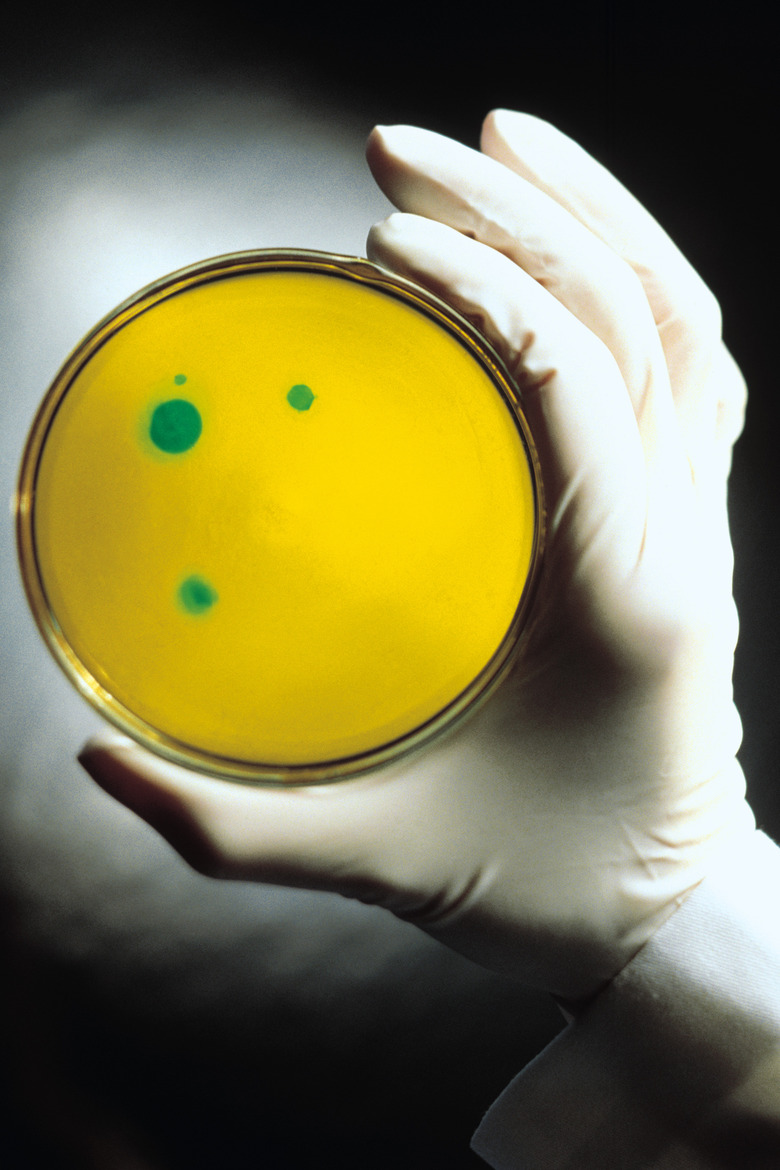What Is An Example Of A Colony In Microbiology?
Microbiology is the study of microbes. "Microbe" is a catchall term that includes all single-celled organisms — the bacteria and archaea, protists and some fungi; a few very small multicellular organisms; and the non-organismic lifelike phenomena, viruses, prions, virions and viroids. Many microscopic organisms form colonies. Individuals in some colonies are all descended from the same parent cell. In others, free-living individuals come together to form colonies at certain life cycle stages.
Seeing the Unseen
Seeing the Unseen
While colonies are made up of microscopic entities, the colony itself is often visible. Microbiology uses cell culture — the intentional growth of colonies, particularly of bacteria and fungi — for research and diagnostics. This involves placing samples of microbes or infectious material in solution onto plates of growth medium and incubating them for a set period. The microbiologist then examines the colonies' color, shape, edges and surface features as the first step in identifying the microbes.
Agent and Host
Agent and Host
Escherichia coli is a very common colony-forming bacterium. It's normally present in the guts of many vertebrates and in most vertebrates' feces, but some virulent strains produce severe illness. E. coli colonies are a familiar feature of microbiology labs because of this bacterium's significance in human and animal health. They're also used to study the activity of various viruses because E. coli cells are themselves victims of other microbes.
Aquatic Community
Aquatic Community
Carchesium are a genus of ciliated freshwater and marine protozoa. They congregate into treelike colonies as long as a perfectly visible eighth of an inch. Colonies are composed of hundreds of individuals that move together like a single organism. The colonies prefer to attach to decaying plant matter, where they feed on bacteria, but they'll form on other surfaces, including the hides of live marine animals.
Water Slime
Water Slime
Chlorophytes are single-celled freshwater green algae. They can form colonies that look like living sheets of green or red slime over submerged objects or on the water's surface. Hydrodictyon is a genus of colonial chlorophyte. It's called "water net" and colonies of many smaller, new cells form inside giant, expanding parent cells, which can themselves form colonies.
Walking Slime
Walking Slime
The slime molds include three unrelated phyla, all classified as protists even though some are multicellular. They spend their youths as free-living, amoeba-like individuals. However, under certain conditions these individuals congregate to form a single entity, with different body parts formed by different former amoeboids. Slime molds were long considered consummate examples of colonial microorganisms, but further study has revealed that the colonial stages are far more similar to multicellular organisms than to other microbial colonies.
References
- ScienceProfOnline: Bacterial Colony Morphology & Identification of Bacteria
- American Society for Microbiology Microbe Library: Colony Morphology Protocol
- MicrobiologyInPictures.com: Escherichia coli
- Dallas County Community College District: Bacterial Colony Morphology [PDF]
- Micrographia.com: Colonial Ciliates
- Microscopy-UK: Green Algae
Cite This Article
MLA
Libal, Angela. "What Is An Example Of A Colony In Microbiology?" sciencing.com, https://www.sciencing.com/example-colony-microbiology-18408/. 24 April 2017.
APA
Libal, Angela. (2017, April 24). What Is An Example Of A Colony In Microbiology?. sciencing.com. Retrieved from https://www.sciencing.com/example-colony-microbiology-18408/
Chicago
Libal, Angela. What Is An Example Of A Colony In Microbiology? last modified August 30, 2022. https://www.sciencing.com/example-colony-microbiology-18408/
